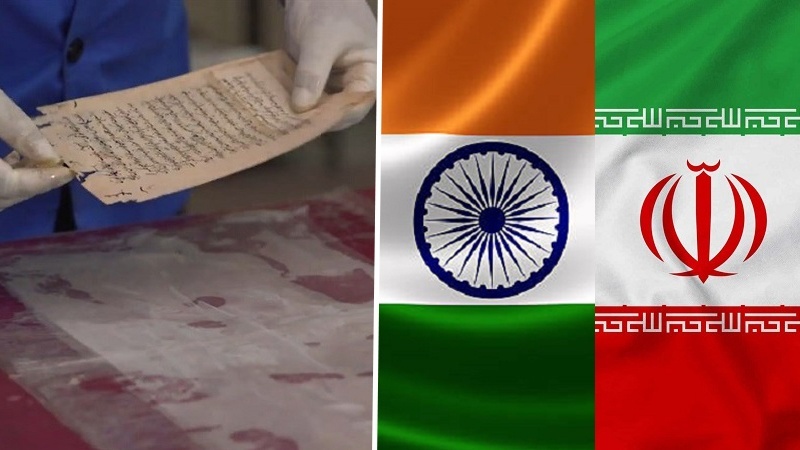AhlulBayt News Agency: The Noor International Microfilm Center is restoring and digitizing 33 million pages of documents in Farsi, which are available at the government records center of the Indian state of Andhra Pradesh.
The Andhra Pradesh State Archives and Research Institute has a treasure of valuable documents from the Bahmani, Qutb Shahi, Adel Shahi, Mughal and Asaf Jahi, East India Company and post-independence India, which are in Farsi, Telugu, Kannada, Marathi, Urdu and English.
Mehdi Khajehpiri, the director of the Noor International Microfilm Center, which is active in India, announced: The Andhra Pradesh State Archives has more than 43 million documents, and among these documents, 33 million documents are in Farsi, which can be described as part of the common heritage of Iran and India.
Khajehpiri considered the Farsi documents of this collection to be illuminating the cultural, scientific and historical relations between Iran and India, and said: These documents have a great impact on deepening the cultural relations between the two countries.
Asadollah Ashtiani, a researcher in the field of documents, says in this regard: In the Andhra Pradesh center, there are various documents in the field of army system and feudal system, letters and correspondence of Iranians.
In 2023, an agreement was signed between the Indian government and Iran, represented by the Noor International Microfilm Center, which some experts describe as the "most important cultural document of Iran and India".
According to this agreement, the Noor International Microfilm Center operates in four areas of digitization, cataloging, restoration of historical documents and organization of these resources.
Since the start of this project, two million documents have been digitized, and also 42,000 documents in the form of 53 volumes of books have been cataloged, and 580,000 pages of documents from this archive have been restored.
Today, an important part of the cultural relations between the two countries is focused on preserving and reviving the common heritage of India and Iran.
In line with the bilateral cultural interactions between Iran and India, last year, a meeting on "The Status of the Farsi Language in India" was held at the Indian Cultural Center in Tehran.
Balram Shukla, the Indian cultural counselor in Iran, announced at the meeting: The Farsi language cannot be separated from Indian history, and the bond created between Iran and India through this language is inseparable.
Rudra Gaurav Shresth, the Indian ambassador to Iran, also stated at the ceremony that knowing Farsi is very important for communication between the culture and customs of the two countries, and emphasized: The Farsi language has played an important role in the cultural commonalities of the two countries, and these interactions should continue.
/129
The Andhra Pradesh State Archives and Research Institute has a treasure of valuable documents from the Bahmani, Qutb Shahi, Adel Shahi, Mughal and Asaf Jahi, East India Company and post-independence India, which are in Farsi, Telugu, Kannada, Marathi, Urdu and English.
Mehdi Khajehpiri, the director of the Noor International Microfilm Center, which is active in India, announced: The Andhra Pradesh State Archives has more than 43 million documents, and among these documents, 33 million documents are in Farsi, which can be described as part of the common heritage of Iran and India.
Khajehpiri considered the Farsi documents of this collection to be illuminating the cultural, scientific and historical relations between Iran and India, and said: These documents have a great impact on deepening the cultural relations between the two countries.
Asadollah Ashtiani, a researcher in the field of documents, says in this regard: In the Andhra Pradesh center, there are various documents in the field of army system and feudal system, letters and correspondence of Iranians.
In 2023, an agreement was signed between the Indian government and Iran, represented by the Noor International Microfilm Center, which some experts describe as the "most important cultural document of Iran and India".
According to this agreement, the Noor International Microfilm Center operates in four areas of digitization, cataloging, restoration of historical documents and organization of these resources.
Since the start of this project, two million documents have been digitized, and also 42,000 documents in the form of 53 volumes of books have been cataloged, and 580,000 pages of documents from this archive have been restored.
Today, an important part of the cultural relations between the two countries is focused on preserving and reviving the common heritage of India and Iran.
In line with the bilateral cultural interactions between Iran and India, last year, a meeting on "The Status of the Farsi Language in India" was held at the Indian Cultural Center in Tehran.
Balram Shukla, the Indian cultural counselor in Iran, announced at the meeting: The Farsi language cannot be separated from Indian history, and the bond created between Iran and India through this language is inseparable.
Rudra Gaurav Shresth, the Indian ambassador to Iran, also stated at the ceremony that knowing Farsi is very important for communication between the culture and customs of the two countries, and emphasized: The Farsi language has played an important role in the cultural commonalities of the two countries, and these interactions should continue.
/129

